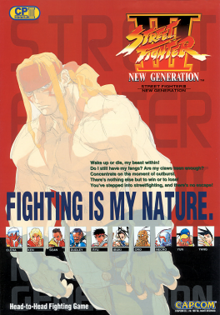| Street Fighter III | |
|---|---|
 European arcade flyer | |
| Developer(s) | Capcom |
| Publisher(s) | Arcade Capcom Dreamcast |
| Producer(s) | Tomoshi Sadamoto Noritaka Funamizu (general producer) Yoshiki Okamoto (general producer) |
| Designer(s) | Yasuhiro Seto Tomonori Ohmura Shinichiro Obata |
| Programmer(s) | Kazuhito Nakai Tate Yas |
| Artist(s) | Ball Boy Q Yu-suke D Kurita |
| Composer(s) | Hideki Okugawa Yuki Iwai |
| Series | Street Fighter |
| Platform(s) | Arcade, Dreamcast |
| Release | Arcade Dreamcast |
| Genre(s) | Fighting |
| Mode(s) | Up to 2 players simultaneously |
| Arcade system | CP System III |
Street Fighter III: New Generation (Japanese: ストリートファイターIII -New Generation-) is a 1997 fighting game in Capcom's Street Fighter series, originally released as a coin-operated arcade game. The game, which was designed as a direct sequel to Street Fighter II (1991), initially discarded every previous character except for Ryu and Ken (hence the "New Generation" subtitle), introducing an all-new roster led by Alex. Likewise, a new antagonist named Gill took over M. Bison's role from the previous games as the new boss character.
Street Fighter III was produced for the CD-ROM-based CP System III hardware,[5] which allowed for more elaborate 2D graphics than the CPS II-based Street Fighter Alpha games (the previous incarnation of the Street Fighter series), while revamping many of the play mechanics. Despite the popularity of 3D polygonal fighting games at the time, Capcom decided to keep this game in 2D; 3D graphics was instead implemented in the spin-off game, Street Fighter EX.
Street Fighter III was followed by two updates: Street Fighter III: 2nd Impact in 1997 and Street Fighter III: 3rd Strike in 1999. A single home version of the game was released for the Dreamcast in 1999 and 2000, in a two-in-one compilation titled Street Fighter III: Double Impact, which also includes 2nd Impact. Street Fighter III received a mainly positive reception, although did not manage to be a hit like its predecessor; it was followed up by Street Fighter IV (2008).
- ^ "HISTORY | Street Fighter 35th Anniversary Site | CAPCOM".
- ^ "Capcom: Buzz Bin". 1997-06-16. Archived from the original on 1997-06-16. Retrieved 2023-10-05.
- ^ "Street Fighter III: Double Impact Now Available". 2001-04-19. Archived from the original on 2001-04-19. Retrieved 2023-04-21.
- ^ I. G. N. Staff (1999-10-21). "New Capcom Japanese Release Dates". IGN. Retrieved 2023-04-21.
- ^ Webb, Marcus (November 1996). "Street Fighter 3 in December". Next Generation. No. 23. Imagine Media. p. 22.